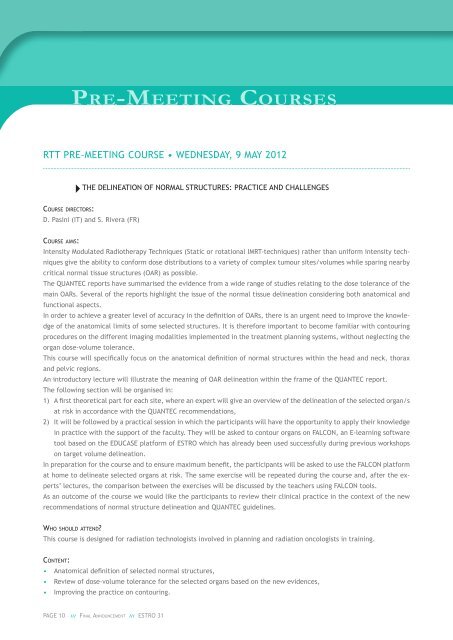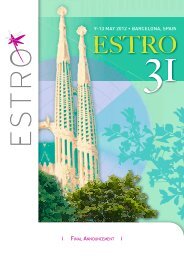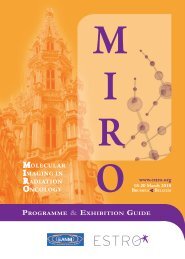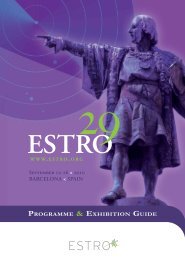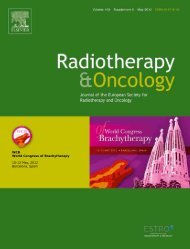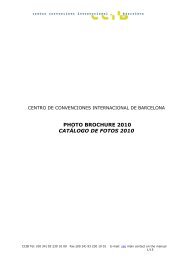9-13 May 2012 • Barcelona, Spain - Estro-events.org
9-13 May 2012 • Barcelona, Spain - Estro-events.org
9-13 May 2012 • Barcelona, Spain - Estro-events.org
You also want an ePaper? Increase the reach of your titles
YUMPU automatically turns print PDFs into web optimized ePapers that Google loves.
Pre re-M -Meeting eeting CCourses<br />
ourses Scientific<br />
cientific PProgramme<br />
rogramme<br />
RTT PRe-MeeTIng COuRSe <strong>•</strong> WeDneSDaY, 9 MaY <strong>2012</strong><br />
THe DeLIneaTIOn OF nORMaL STRuCTuReS: PRaCTICe anD CHaLLengeS<br />
course dIrectors:<br />
D. Pasini (IT) and S. Rivera (FR)<br />
course aIms:<br />
Intensity Modulated Radiotherapy Techniques (Static or rotational IMRT-techniques) rather than uniform intensity techniques<br />
give the ability to conform dose distributions to a variety of complex tumour sites/volumes while sparing nearby<br />
critical normal tissue structures (OaR) as possible.<br />
The QuanTeC reports have summarised the evidence from a wide range of studies relating to the dose tolerance of the<br />
main OaRs. Several of the reports highlight the issue of the normal tissue delineation considering both anatomical and<br />
functional aspects.<br />
In order to achieve a greater level of accuracy in the definition of OaRs, there is an urgent need to improve the knowledge<br />
of the anatomical limits of some selected structures. It is therefore important to become familiar with contouring<br />
procedures on the different imaging modalities implemented in the treatment planning systems, without neglecting the<br />
<strong>org</strong>an dose-volume tolerance.<br />
This course will specifically focus on the anatomical definition of normal structures within the head and neck, thorax<br />
and pelvic regions.<br />
an introductory lecture will illustrate the meaning of OaR delineation within the frame of the QuanTeC report.<br />
The following section will be <strong>org</strong>anised in:<br />
1) a first theoretical part for each site, where an expert will give an overview of the delineation of the selected <strong>org</strong>an/s<br />
at risk in accordance with the QuanTeC recommendations,<br />
2) It will be followed by a practical session in which the participants will have the opportunity to apply their knowledge<br />
in practice with the support of the faculty. They will be asked to contour <strong>org</strong>ans on FaLCOn, an e-learning software<br />
tool based on the eDuCaSe platform of eSTRO which has already been used successfully during previous workshops<br />
on target volume delineation.<br />
In preparation for the course and to ensure maximum benefit, the participants will be asked to use the FaLCOn platform<br />
at home to delineate selected <strong>org</strong>ans at risk. The same exercise will be repeated during the course and, after the experts’<br />
lectures, the comparison between the exercises will be discussed by the teachers using FaLCOn tools.<br />
as an outcome of the course we would like the participants to review their clinical practice in the context of the new<br />
recommendations of normal structure delineation and QuanTeC guidelines.<br />
Who should attend?<br />
This course is designed for radiation technologists involved in planning and radiation oncologists in training.<br />
content:<br />
<strong>•</strong> anatomical definition of selected normal structures,<br />
<strong>•</strong> Review of dose-volume tolerance for the selected <strong>org</strong>ans based on the new evidences,<br />
<strong>•</strong> Improving the practice on contouring.<br />
WHaT’S neW aT eSTRO 31?<br />
ESTRO<br />
31<br />
<strong>2012</strong><br />
1. The scientific programme of eSTRO 31 will be enriched by special sessions in an ‘Interdisciplinary Track’ where relevant<br />
topics for radiation oncologists, physicists, radiobiologists and RTTs will be addressed jointly. not sure which<br />
sessions you could attend? To make it more convenient for you, for each session of this track, the discipline of relevance<br />
is indicated.<br />
2. Have a closer look at the ‘Look Inside’ (LI) sessions. The format of these sessions allows for approximately 66% of the<br />
time for presentation of theory followed by approximately 33% of the time for illustration via practical examples.<br />
3. Debates (D) have been designed in the Oxford example with point and counterpoint discussions followed by conclusions<br />
in support and against of the stance taken by the debaters.<br />
4. We continue in the tradition of Joint Sessions (JS) with other societies such as aSTRO, eau, eCCO, eFOMP, eSMO,<br />
eSSO, eORTC, eanM and PROS.<br />
5. need some guidance in deciding which sessions would be most beneficial for you to attend? Here are the topics<br />
that will be addressed on the main conference days.<br />
thursday, 10 may <strong>2012</strong><br />
The small volume challenge; Cutting edge technology; Data management and networks; Targeting perspective in<br />
Radiobiology; adaptive RT: changing the practice<br />
FrIday, 11 may <strong>2012</strong><br />
The children, young and elderly patients deal; Theragnostic and Imaging in RT; Quality assurance of new techniques<br />
and technologies; Microenvironment<br />
saturday, 12 may <strong>2012</strong><br />
Current practice and moving controversies; Dosimetry challenges; Theragnostic and Imaging in RT; normal tissue;<br />
Radiobiological principles for RTT practice<br />
sunday, <strong>13</strong> may <strong>2012</strong><br />
Current practice and moving controversies; Predictive biomarkers in RT; Dose calculation and optimization; Looking<br />
forward; Stem cells; RTT responsibilities and involvement in research<br />
Page 10 /// FInal announcement /// eSTRO 31 eSTRO 31 /// FInal announcement /// Page 11


